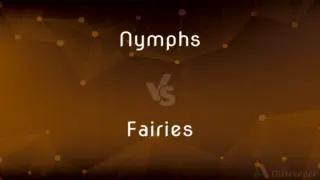Rebonding vs. Straightening — What's the Difference?
Edited by Tayyaba Rehman — By Fiza Rafique — Published on December 13, 2023
Rebonding is a chemical process that restructures hair bonds for long-lasting straightness, while straightening is a temporary technique using heat tools.

Difference Between Rebonding and Straightening
Table of Contents
ADVERTISEMENT
Key Differences
Rebonding refers to a hair treatment that utilizes chemicals to permanently alter the structure of hair, making it straight. This process breaks and rearranges the hair's natural bonds. On the other hand, straightening typically involves the use of heat tools, like flat irons, to temporarily straighten the hair.
When considering longevity, rebonding offers a more long-term solution, with results lasting several months until new hair growth appears. In contrast, straightening with heat tools offers only temporary results, with hair returning to its natural state after washing or exposure to humidity.
Rebonding requires a more extensive and time-consuming salon procedure, often with multiple steps involving applying chemicals, neutralizing, and then rinsing. Straightening, however, can be done quickly at home or in a salon, merely by using a flat iron or blow dryer.
Due to its chemical nature, rebonding can be more damaging to the hair in the long run, potentially leading to dryness and breakage if not cared for properly. In contrast, while straightening with heat tools can also cause damage, it's usually less severe unless done frequently and without heat protection.
For those desiring a permanent change in their hair's texture, rebonding is the ideal choice. But for individuals looking for a quick and temporary change, straightening would be more appropriate.
ADVERTISEMENT
Comparison Chart
Method
Chemical process
Heat tool technique
Duration
Long-term (several months)
Temporary (until next wash)
Procedure Complexity
Extensive salon procedure
Quick, can be done at home
Potential Damage
Can be damaging if not cared for
Less damaging, unless done frequently without protection
Ideal For
Permanent texture change
Temporary change in hair look
Compare with Definitions
Rebonding
A chemical treatment to permanently straighten hair.
After rebonding, her curly hair transformed into sleek, straight locks.
Straightening
Often done using tools like flat irons or blow dryers.
Her favorite tool for straightening is her ceramic flat iron.
Rebonding
Typically requires a professional salon visit due to its complexity.
She booked an appointment at the salon for her rebonding session next week.
Straightening
Results last until the hair is washed or exposed to humidity.
After straightening, she avoids rain to maintain her hairstyle.
Rebonding
Provides long-lasting straightness until new growth appears.
With rebonding, she only needs touch-ups every few months for the new growth.
Straightening
Can cause damage if done frequently without heat protection.
She always applies a heat protectant before straightening her hair.
Rebonding
Alters the hair's structure by rearranging its natural bonds.
Rebonding works by breaking and then re-forming the hair's bonds.
Straightening
Suitable for quick, temporary changes in hairstyle.
For the party tonight, she's thinking of straightening her wavy hair.
Rebonding
Can be more damaging if not properly maintained post-treatment.
To keep her hair healthy after rebonding, she invested in deep conditioning treatments.
Straightening
A method of temporarily straightening hair using heat.
She uses straightening every morning to achieve a polished look.
Rebonding
Infl of rebond
Straightening
To make or become straight or straighter.
Straightening
Infl of straighten
Straightening
The act of making something straight.
Common Curiosities
Can I do rebonding at home?
Due to its complex and chemical nature, rebonding is best done by professionals in a salon.
What is rebonding?
Rebonding is a chemical process that permanently straightens hair by restructuring its natural bonds.
How long does rebonding last?
Rebonding can last for several months, with touch-ups needed for new hair growth.
Is straightening harmful to the hair?
Straightening can be damaging if done frequently without heat protection, but is generally less damaging than rebonding.
Can straightened hair be reverted to its natural state?
Yes, washing the hair or exposing it to humidity will revert its form.
How does straightening differ from rebonding?
Straightening is a temporary method using heat tools, while rebonding offers long-term straightness through chemicals.
Can rebonded hair be curled?
Yes, but it's advisable to wait a few weeks post-rebonding to avoid excessive damage.
How soon can I wash my hair after straightening?
You can wash it immediately, but the straightened effect will wear off.
How can I maintain my rebonded hair?
Use sulfate-free shampoos, deep condition regularly, and avoid excessive heat styling.
How often should I straighten my hair?
It depends on personal preference, but using heat protection and not straightening daily can minimize damage.
Are there any side effects to rebonding?
Potential side effects include dryness, hair breakage, and scalp irritation if not done correctly.
What's the best heat setting for straightening?
It varies based on hair type, but always start with a lower setting and increase if necessary.
Which is better for hair health: rebonding or straightening?
Both have potential to damage, but straightening is generally less harmful if done infrequently with proper precautions.
Is there a natural way to straighten hair?
While no natural method matches the effect of heat or chemical treatments, some techniques like hair wrapping or using aloe vera can offer milder straightening results.
How much does rebonding cost?
Costs vary based on salon, location, and hair length, but it's generally more expensive than a regular straightening session.
Share Your Discovery

Previous Comparison
Nymphs vs. Fairies
Next Comparison
Education vs. SocializationAuthor Spotlight
Written by
Fiza RafiqueFiza Rafique is a skilled content writer at AskDifference.com, where she meticulously refines and enhances written pieces. Drawing from her vast editorial expertise, Fiza ensures clarity, accuracy, and precision in every article. Passionate about language, she continually seeks to elevate the quality of content for readers worldwide.
Edited by
Tayyaba RehmanTayyaba Rehman is a distinguished writer, currently serving as a primary contributor to askdifference.com. As a researcher in semantics and etymology, Tayyaba's passion for the complexity of languages and their distinctions has found a perfect home on the platform. Tayyaba delves into the intricacies of language, distinguishing between commonly confused words and phrases, thereby providing clarity for readers worldwide.












































